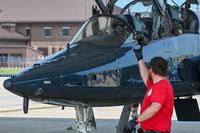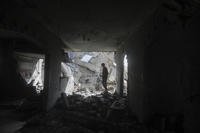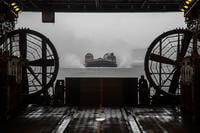
The short-takeoff-and-vertical-landing (STOVL) F-35B is either what makes the Joint Strike Fighter (JSF) program the stuff of genius -- or a sure bet for failure.
Think about it.
With the F-35B, the JSF program lays claim to an unprecedented aerodynamic hat trick: one common fighter design/three very, very different ways to take off and land. On the other hand, the F-35B is the biggest headache to develop and is already the leading cause for a two-year-delay and $5 billion cost overrun. And the aircraft still has yet to fly.
The F-35B also happens to be the diplomatic glue that attracts an international partnership to chip in one-tenth of the JSF's development cost. Only two of the eight JSF partners want the STOVL aircraft, but one of those is the UK. And if the JSF program loses the UK, you may say goodbye to the rest of the international partners and hello to Eurofighter Typhoon Tranche 3. (Without international cover, the JSF also may look a lot more inviting to the increasingly rapacious budget-cutters in the Pentagon.)
So let's hope the F-35B's largest customer -- the US Marine Corps -- knows what it's doing.
It is in this context that I was so interested to read the new book, Harrier II: Validating V/STOL, by Lon O. Nordeen. Perhaps, by understanding why the USMC believes the Harrier -- and the F-35B -- are so necessary, we may understand the disporportionate influence it wields over the JSF program.

First, it has to be understood that, historically-speaking, V/STOL is an aerodynamic fetish. To understand this point, please check out the aptly-titled V/STOL Wheel of Misfortune. Of the 45 V/STOL projects attempted in history, only four -- the Harrier, the V-22, the CL-84, and F-35B --ventured much beyond the prototype stage. Three of them involve the Marines.
In his book, Nordeen unfortunately chooses not to analyze or comment but to straightforwardly present the USMC's obsession with the Harrier as a product of Vietnam. Close air support seemed to be quite a topic of discussion (imagine that?) at the time. To deal with the issue, the Air Force wanted to buy the A-10, the Army favored the Lockheed AH-56A Cheyenne and the USMC focused on the AV-8A Harrier. Asked by Congress to pick the best option, DOD (surprise!) backed all three. (The Cheyenne was later cancelled.)
It's clear from Nordeen's writing that the USMC likes V/STOL because of the obvious: its fighters don't need a long runway or an aircraft carrier to take off. In the Falklands War, Royal Air Force GR Mk. 3 Harriers arrived -- and operated -- in the South Atlantic war zone on board the container ship Atlantic Conveyor (until the ship was struck by an Argentine exocet missile). Such basing flexibility briefly appealed to the US Air Force, which in 2004 and 2005 flirted with the idea of buying a bunch of F-35Bs.
Whether that flexibility is really worth the price in reduced aerodynamic performance and increased maintenance burden is unfortunately not within the scope of Nordeen's book. Even within his chosen limits, however, it is negligent as a historian for him to omit any reference to the Harrier's tragically horrendous safety record.
While the V/STOL Harrier fleet were a potent force in the Falklands conflict, the advantage of basing flexibility alone hasn't proved pivotal in any modern engagement since. It is impressive to think of the devotion the Marines lavish on this one aerodynamic quality, perhaps to the detriment of all else.








